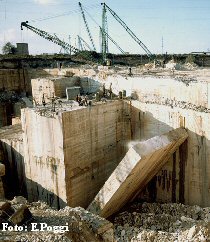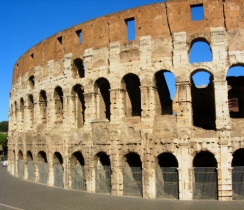Travertine is often used as a building material and is in use for over 4000 years as a fundamental key in construction. Known since the earliest times, the stone was used most widely in construction throughout Greece, Turkey and Italy. The Romans was the first people to use travertine on a large scale, also in building in many parts of Italy and Europe (also in Britain: the lighthouse at Dover (I century) is the best preserved British example).
Travertine was employed as huge blocks in the monumental buildings; the largest building in the world constructed mostly of travertine is the Colosseum.


Quarry of travertine in Tivoli
Travertine use continued through the Middle Ages but was especially popular during the Italian Renaissance (used, for example, to built the famous Trevi Fountain or the colonnade and gate of St Peter's Basilica) and the Fascist periods (used to constructe the quarter Eur, in Rome).
Nowadays the travertine is one of the most frequently used stones in modern architecture thanks to the quarries of Tivoli that use the latest techiniques to produce mostly thin slabs to be used as fašade material, wall cladding, and flooring. Quarried blocks with uncut faces are used in garden and aquarium decoration.


Colosseo
The Tivoli's travertine is imported into the UK and USA extensively and used as a flooring material. In London it has been used in the internal facing at Piccadilly Underground Station, Senate House, the new British Library and Broadgate Circle.
Notable and recently buildings using travertine extensively include the Sacre Coeur Basilica in Paris and the Getty Center in Los Angeles, California. All of this travertine was mined and imported from Tivoli.
In the United States there is a million tonnes demand which is mostly met by imports: most of these imports come from Tivoli.






